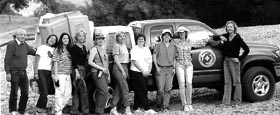 What we do
What we do
As the Los Angeles area’s premier wildlife medical treatment and rehabilitation facility, California Wildlife Center strives to ensure that each patient receives optimal care, allowing them to return to their wild state. Since 1998, CWC has greatly expanded our capacity to treat more than 60,000 total animal patients, many whose injuries were caused by the impacts of their urbanized environments. CWC is one of only a few wildlife rehabilitation centers in the area, and the only facility in Los Angeles County permitted to rehabilitate mule deer fawns, coyote pups, crows and ravens, and hatchling and fledgling songbirds. We are also the only wildlife center in California that cares for both land and marine animals. CWC treats more than 170 unique animal species.
Our goal at CWC is to keep native fauna wild by rehabilitating animals as quickly as possible and releasing them back into their native territory. We also strive to educate the public in peaceful co-existence with wildlife to reduce human/animal conflict.
California Wildlife Center accepts animals 365 days a year, at no cost, directly from the public, through our relationships with regional animal care centers, and from local veterinarians.
Along with treating wildlife, CWC fields 35,000 calls annually from members of the public. Staff and volunteers guide people who have found an animal in need of help as well as answer general questions about native fauna. CWC also provides educational outreach to schools and community groups to share ways to peacefully coexist with wildlife.
Dedicated to the future of veterinary medicine and wildlife rehabilitation, CWC provides a variety of professional training programs, including wildlife and marine mammal rescue and rehabilitation internships and externships in wildlife medicine for veterinary students. In 2022, these programs provided over 12,000 hours of hands-on experience to young adults interested in wildlife rehabilitation and medicine.
California Wildlife Center participates in 15 research programs with nationally-recognized organizations relevant to the long-term health and sustainability of local wildlife populations. CWC actively submits numerous animal carcasses for evaluation, diagnosis, and monitoring of possible infectious agents within the wild animal population. Though an animal may be too ill or injured to survive rehabilitation, they may act as sentinels to new and emerging diseases in the environment.
Why What We Do Matters
When people learn about the hardships animals face each day, they are more willing to take a proactive approach toward protecting the natural environment and the habitats of our wild neighbors. At CWC, we educate communities, and in doing so, we are challenging homeowners, teachers, students and businesses to continue learning about our environment and enriching the lands in which we live and play.
Many people call us for advice on how to live with wildlife. You will find helpful tips for coexisting with and respecting wild animals in our Coexisting with Wildlife section.


 What we do
What we do In a quiet oak grove in the Santa Monica Mountains – on land generously provided by California State Parks – sick, injured and orphaned native wildlife receive quality medical care and rehabilitation, with the intent of releasing them back into the wild.
In a quiet oak grove in the Santa Monica Mountains – on land generously provided by California State Parks – sick, injured and orphaned native wildlife receive quality medical care and rehabilitation, with the intent of releasing them back into the wild.